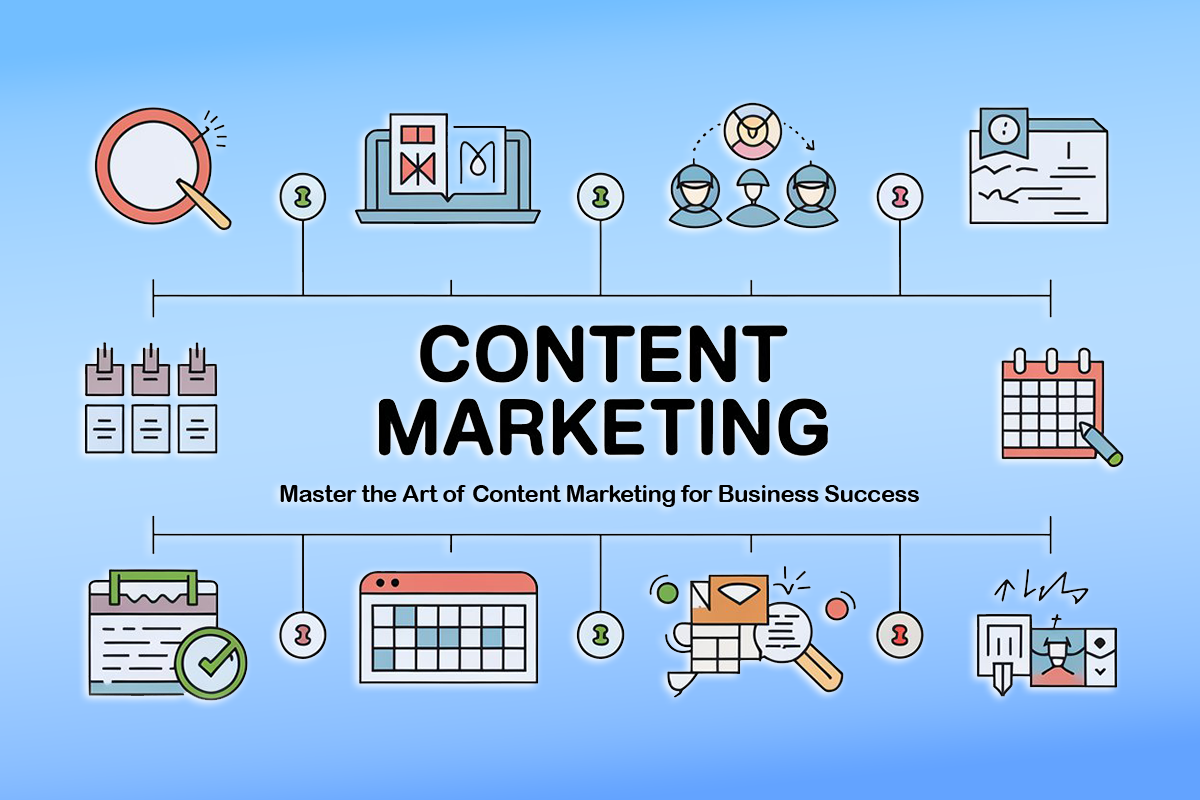Content Marketing is now one of the most important weapons in the arsenal of a modern business’s strategy, by acting as a powerful tool for building brand awareness, engaging audiences, and driving conversions. In the current market, where consumers are flooded with information, creating valuable and relevant content is crucial for businesses to cut through the noise and connect with their target audience effectively.
Content Marketing Strategy Development
Developing a winning and memorable content marketing strategy requires careful planning and having a clear cut about your businesses goals, target audience, and market trends. A successful strategy must define clear goals, make sure of the target audience personas, identify the main distribution channels and establish some metrics for measuring success. By placing your content efforts with your overall business goals, you can ensure that every piece of content created is used for a specific purpose to drive your business’s success upward.
What does a Successful Content Marketing Plan include:
Know Your Audience: Research your target audience’s demographics, likes and dislikes, pain points, and overall behaviours.This will help you decide which types of content to create and where to distribute it.
Setting Clear Goals: Make and follow specific, measurable goals for your content marketing efforts, such as increasing brand awareness, driving website traffic, generating leads, or boosting sales.
Content Calendar and Distribution Plan: Create a content calendar noting down the topics, formats, and publishing schedule for your content. Choose which channels (website, blog, social media platforms, or email newsletters) will be used to distribute your content to reach your target audience effectively.
Content Creation and Publishing Workflow: Form a streamlined process for content creation, editing, approval, and publishing to make sure of consistency and quality across all your content efforts.
Content Creation Best Practices
Creating engaging content is important for attracting the attention of your audience and keeping them coming back for more. Whether you are writing blog posts, creating videos, or designing infographics, the following best practices can help you create content that connects with your audience:
You can begin by identifying relevant topics that satisfy your audience’s interests or pain points. Design your posts with convincing headlines, clear formatting, and visual elements that improve readability. Use storytelling, data-driven insights, and actionable advice to provide value to your audience.
Consider your target audience’s motivations and use compelling language to force them to take action. Focus on the benefits of your products or services, deal with common issues or complaints, and include clear calls to action to bring more conversions.
SEO and Content Marketing
Optimising your content for search engines is important for increasing visibility and driving more organic traffic to your website. By adding relevant keywords, optimising meta tags, and improving site design, you can always improve your content’s discoverability and ranking on search engine results pages (SERPs).
Key aspects of SEO and Content Marketing:
Perform keyword research to identify high-volume, low-competition keywords relevant to your industry and target audience. Add these keywords naturally to your content, including headings, subheadings, meta descriptions, and image alt tags. Focus on producing high-quality, accurate content that provides value to your audience and encourages backlinks from other reliable websites
Keywords play a critical role in helping search engines understand the relevance and context of your content. However, keyword stuffing or over-optimization can have a negative impact on user experience and search engine rankings. Instead, focus on creating extensive, well-crafted content that deals with the needs of your target audience while naturally including relevant keywords.
Visual Content and Design
Visual content, such as infographics, videos, and images, can significantly improve the effectiveness of your content marketing efforts by making your content more engaging, memorable, and shareworthy. Including visually appealing design elements can help attract the attention of your audience and communicate complex information more effectively.
Key elements for visual content and design:
Infographics are a powerful tool to present data, statistics, or processes in a visually appealing and easy to understand format. While creating infographics, focus on simplifying complex data, using eye-catching visuals, and maintaining a consistent design aesthetic that aligns with your brand.
In addition to the written content, including visually appealing design elements into your blog posts can help break up text, improve readability, and increase engagement. Use high-quality images, graphics, and multimedia content to improve your posts and make them more shareworthy on social media platforms.
Content Repurposing
Content repurposing involves taking existing content assets and adapting them into different formats or for different distribution channels to maximise their reach and effectiveness. By repurposing content, you can extend the lifespan of your content assets, reach new audiences, and strengthen important messages across multiple touchpoints.
Strategies for content repurposing:
Begin your strategy by identifying your top-performing content assets and determining how they can be repurposed into different formats, such as blog posts, videos, podcasts,or social media posts. Customise the format and messaging to suit the tastes of your target audience on each platform.
Most long-form content, such as blog posts or whitepapers can be repurposed into shorter formats, such as infographics, slideshow presentations, or video tutorials. Redesign content into different formats to appeal to the different learning styles and consumption preferences of the audiences.
Content Marketing Tools and Resources
A wide array of tools and resources are available to simplify and improve your content marketing efforts, from content creation and distribution to analytics and optimization. By making use of the right tools, you can increase efficiency, improve collaboration, and achieve better results with your content marketing strategies.
Some top content marketing tools:
Content creation tools, such as Grammarly for proofreading and editing, Canva for graphics designing, and CoSchedule for managing editorial calendars and social media scheduling, can help in organising your content creation process and improving your efficiency.
While most of the content marketing tools offer free versions with limited features, investing in paid tools can provide access to game-changing advanced features, premium support, and improved functionality. Consider your budget, specific needs, and long term objectives when deciding whether to invest in paid content marketing tools or not.
Measuring the Success of Your Content Marketing
Measuring the effectiveness of your content marketing strategies is important to optimise performance, identify improvement areas and demonstrate the ROI to key stakeholders. By tracking key metrics and analysing performance data, you can gain valuable insights into what works well and what must be adjusted to achieve better results.
Key metrics to track content marketing success:
Common metrics include organic website traffic, engagement metrics (bounce rate, time on page, and social shares), lead generation and conversion rates, return on investment (ROI). Use web analytics tools, such as Google Analytics or Adobe Analytics, to track and analyse these metrics over time.
Once the data has been collected on the key metrics, it is important to analyse the results and identify patterns, trends, and improvement areas. Here’s how you analyse and improve your content performance:
Review engagement metrics such as time on page, bounce rate, and social shares to calculate how well your content connects with your audience. Look for patterns in the type of content or topics that generate the highest levels of engagement and update your content strategy accordingly.
Track conversion metrics, such as lead generation, email sign-ups, or sales, to measure the effectiveness of your content in driving desired actions. Select high-converting content pieces and analyse the factors that contribute to their success, such as convincing calls-to-action (CTA), effective copy, or engaging visuals.
Monitor your content’s performance in search engine results pages (SERPs) and track key SEO metrics, such as keyword rankings, organic traffic, and backlinks. Identify opportunities to optimise your content for better search visibility, such as targeting high-value keywords, improving on-page SEO elements, or getting quality backlinks from reliable websites.
Calculate the return on investment (ROI) for your content marketing strategies by comparing the costs of content creation and distribution to the revenue generated or saved cost as a result of your content. Consider both direct and indirect ROI factors, such as increased brand awareness, customer loyalty, or customer lifetime value.
Based on your analysis, repeat and update your content strategy by making data-driven decisions and carrying out changes to improve performance. Experiment with different content formats, distribution channels, messaging strategies, and targeting tactics to optimise your results over time.
Email Marketing and Content Marketing Integration
Email marketing and content marketing are powerful digital marketing strategies that can work together to drive engagement, nurture leads, and convert visitors into customers. By integrating email marketing with your content strategy, you can deliver valuable content directly to your target audience’s inbox, form and strengthen relationships, and prompt some kind of action.
Effective integration strategies include:
Create content-rich newsletters that provide subscribers with valuable insights, resources, and updates related to your industry. Manage and repurpose existing content from your blog, website, or social media channels to create engaging newsletter content that keeps subscribers informed and engaged.
Use audience division and personalisation techniques to customise your email content to the specific interests, preferences, and behaviours of different subscriber sections. Deliver targeted content recommendations, promotions, or offers based on subscriber data such as demographics, purchase history, or browsing activity.
Make use of email automation tools to simplify your email marketing efforts and deliver timely, relevant content to subscribers at every stage of the customer journey. Set up automated email sequences, such as welcome emails, drip campaigns, or abandoned cart reminders, to nurture leads and drive conversions effectively.
By integrating email marketing with your content strategy, you can amplify the reach and impact of your content, nurture relationships with your audience, and drive measurable results for your business.
Influencer Marketing and Content Collaboration
Influencer marketing involves partnering with individuals or organisations with a significant following and influence in your industry to create and promote content to their audience. By collaborating with influencers, you can take advantage of their credibility, reach, and engagement to amplify your brand message and connect with new audiences.
Strategies for influencer marketing and content collaboration:
Research and identify influencers whose audience demographics, interests, and values agree with your target market and brand objectives. Look for influencers who have a genuine connection with their audience, a strong online presence, and a track record of creating high-quality content.
Cultivate relationships with influencers by interacting with them on social media, commenting on their content, and sharing their posts. Reach out to influencers with personalised outreach messages that highlight the value of collaborating with your brand and propose mutually beneficial partnership opportunities.
Work collaboratively with influencers to co-create content that connects with their audience and agrees with your brand messaging. Whether it’s sponsored blog posts, social media takeovers, or product reviews, involve influencers in the content creation process to make use of their creativity, authenticity, and storytelling abilities.
Track key performance metrics, such as reach, engagement, website traffic, and conversions, to measure the effect of your influencer marketing campaigns. Use tracking links, promo codes, or custom landing pages to indicate traffic and sales generated by influencer-driven content accurately.
By using the reach and influence of trusted voices in your industry, influencer marketing can help you scale up your brand’s reach, build credibility, and drive meaningful engagement with your target audience.
Content Marketing for Lead Generation
Lead generation is a primary objective of content marketing, as it involves attracting and capturing the interest of potential customers and guiding them through the sales funnel. By creating valuable, relevant content that satisfies the needs and pain points of your target audience, you can get good leads and nurture them into potential customers.
Strategies for content marketing for lead generation:
Create content assets, such as blog posts, ebooks, whitepapers, or webinars, that deal with the specific pain points, challenges, or questions commonly faced by your target audience. Customise your content to different stages of the customer journey, from awareness to consideration to decision, to attract and engage visitors at each stage.
Create lead magnets, such as free guides, templates, or toolkits, that offer valuable resources in exchange for contact information, such as email addresses. Promote your lead magnets across your website, blog, social media channels, and email newsletters to attract eligible leads and build your email list.
Design dedicated landing pages for your lead magnets with clear, convincing messaging and calls-to-action that encourage visitors to take the desired action, such as downloading a resource or signing up for a webinar. Optimise your landing pages for conversions by minimising distractions, removing friction points, and testing different elements to improve performance.
Use email marketing automation to nurture leads over time with personalised, relevant content that educates, informs, and builds trust. Develop email sequences that deliver targeted content based on lead behaviour, preferences, and interests to move visitors further down the sales funnel and drive conversions.
By positioning your content marketing efforts with lead generation objectives, you can attract good leads, nurture relationships with customers, and finally drive revenue to your business.
Storytelling in Content Marketing
Storytelling is a powerful technique for capturing the attention of your audience, bringing about powerful emotions, and conveying your brand’s values, personality, and unique selling points. By crafting a convincing brand story that connects with your audience’s goals, challenges, and desires, you can create deeper connections and build loyalty with your customers.
Key principles of storytelling in content marketing:
Develop a deep understanding of your target audience’s demographics, psychographics, and motivations to create stories that connect with their interests, values, and experiences. Use market research, customer feedback, and image development to discover insights into your audience’s needs, preferences, and pain points.
Define your brand’s core values, mission, and unique selling points to cook up your storytelling strategy. Identify key themes, messages, and narratives that communicate what sets your brand apart and why customers should care.
Craft stories that engage your audience emotionally and intellectually, drawing them into your brand’s world and inspiring them to take action. Use storytelling elements such as characters, conflict, resolution, and emotion to create stories that connect with your audience and leave a lasting impression.
Select the most appropriate medium for conveying your brand stories based on your audience’s preferences, content format, and distribution channels. Whether it’s written content, videos, podcasts, or interactive experiences, choose the format that best brings your stories to life and reaches your target audience effectively.
Authenticity is key to successful storytelling in content marketing. Stay true to your brand’s values, voice, and personality, and avoid overly promotional or sales-driven messaging that can undermine the credibility of your stories. Be genuine, transparent, and relatable in your storytelling to build trust and credibility with your audience.
Incorporate customer testimonials, case studies, and success stories into your content to illustrate real-world examples of how your products or services have made a positive impact on people’s lives. Highlight the challenges, solutions, and outcomes of your customers’ journeys to demonstrate the value and benefits of choosing your brand.
Use storytelling to evoke emotions such as joy, empathy, nostalgia, or inspiration that resonate with your audience on a deeper level. By tapping into universal human experiences and emotions, you can create meaningful connections with your audience that foster loyalty and advocacy for your brand.
In conclusion, content marketing is a dynamic and multifaceted discipline that requires careful planning, creativity, and strategic execution to achieve success. By developing a comprehensive content marketing strategy, creating engaging content, leveraging SEO best practices, and measuring performance, businesses can effectively reach their target audience, drive engagement, and achieve their marketing objectives. Whether through storytelling, visual content, influencer partnerships, or lead generation tactics, content marketing offers endless opportunities for brands to connect with their audience, build relationships, and inspire action. By staying up to date, adapting to changing trends, and continually updating their approach, businesses can make use of the power of content marketing to stand out in today’s competitive landscape and drive meaningful results.








